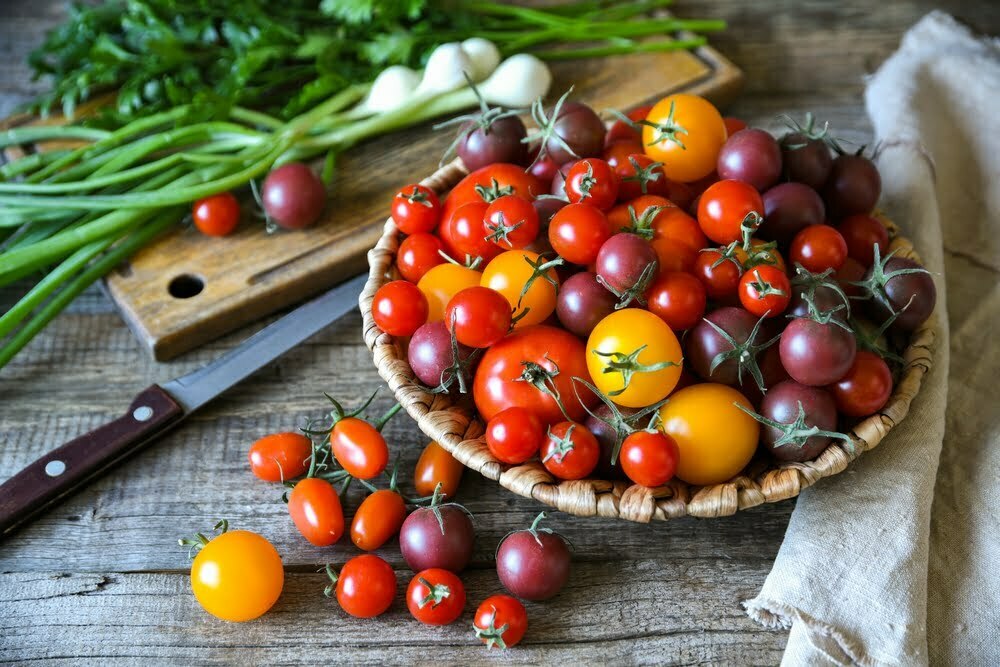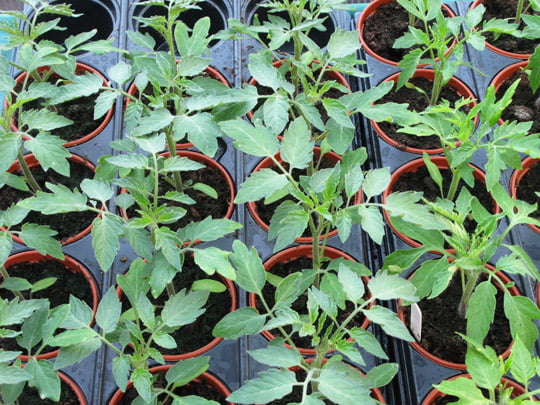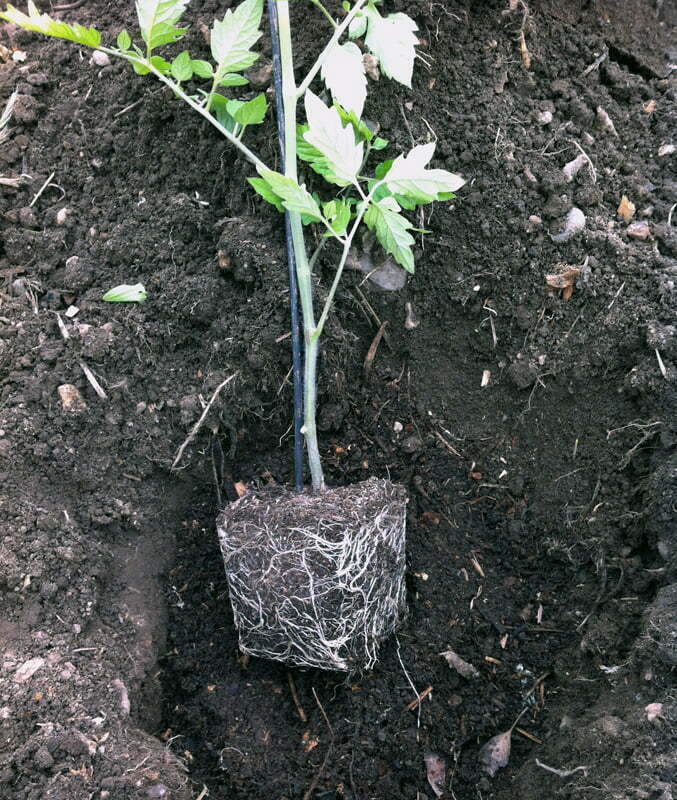In this Article
Tomato plants are a wonderful culinary addition to any spring garden. They are easy to grow and provide an abundance of food beginning in late spring to early summer and lasting well into autumn, depending upon the plant variety and growing zone. Here in the UK, tomato harvests range between July – September and hardening off the tomato seedlings the right way will set you up for a succesful growing season.
Many people like to start their seeds indoors, while it’s still cold outside. Savvy gardeners do this in order to get a head start on the growing season. When we start tomato seeds early (check out ours here), it means that our plants will have time to not only grow bigger, but fruit earlier too. In doing so, we get to enjoy a longer and more robust harvest.

The challenge that comes later, however, is knowing how to acclimatise our seedlings to outdoor living and when it’s safe to house them outside permanently. This is where the practise of “hardening off” your tomato plants comes in. Let’s talk about it.
What Does It Mean to Harden Off a Plant?
As spring approaches and warmer days become more plentiful, most of us will be eager to get seedlings established outside. Before you rush to set your tender young plants outside though, there are a few things to consider and be mindful of.
To harden off a plant means that you are slowly acclimating it to the harsh realities of the outdoor world. You see, your indoor seedlings have never experienced direct sunlight, windy conditions, swinging temperatures, and rainstorms. Therefore, as growers, we want to gradually introduce our plants to the outside, so they have a chance to adapt, survive, and thrive.
Now, if a gardener fails to acclimate their young plants adequately and such plants are forced to suffer through freezing temperatures or scorching sun, they are likely to suffer severe damage. At worst, they may die, or at best, simply fail to thrive. Damaged plants that do survive are often straggly, produce little fruit, and have sparse foliage. Therefore, it’s really important to be attentive to your young seedlings.

In nature, seeds only germinate and begin growing when they sense that the risk of frost has long passed. However, when we start seeds inside, we are simulating the perfect conditions for seedlings to emerge. Therefore, we need to protect them until outdoor temperatures are aligned with their normal growing conditions in the wild.
A Word About Potted Tomato Plants
First things first, you’ll want to decide where you want your tomato plants to live throughout the growing season: in the ground or in large patio pots. Regardless of which long-term growing method you choose to use, you’ll need to re-pot your seedlings a few times as they continue to grow larger and while you wait for the risk of frost to pass. This will enable their root system to spread out more freely and will prevent root binding. Tomato roots can grow up to 2.5 cm per day, so give them plenty of room to expand. Also be careful to prevent root damage as you move your seedlings from one container to another. After each transplant, be sure to water your seedlings to help them cope with the stress of the move.
When picking out a “forever home” for each of your potted tomato plants, pick a large enough container. It’s always a good idea to use at least a 95-litre planter (about 61 cm or 24 inches deep/25 US gal) for each plant, as healthy tomato plants can become quite large when mature. A larger planter size will enable your tomato plant’s root system to fully expand to its full potential. In other words, the larger the root size, the larger the above-ground plant structure will be. To make moving large planters easier, you can utilise plant caddies equipped with rollers.

Additionally, be sure to add premium fertilised soil, optimised for tomatoes. In this way, as your tiny plants begin to adapt to outdoor life, they will have plenty of room to grow and have lots of food to eat. Their soil should be well-draining and lightweight, with lots of organic matter.
Now if you’re planting your tomato seedlings in a dedicated in-ground planter bed, you’ll want to place your tomato plants in that area during warmer days to see how they do. You may need to re-pot them a few times as they grow. Once all risk of frost is past, then they can go into the ground. In the UK, the danger of frost has usually passed by mid-April.
Steps for Introducing Your Seedlings to The Outdoors
Let’s discuss some of the challenges your tomato seedlings will encounter once outside and the proactive steps we can take to make the hardening off process easier for them.
Direct Sunlight
In the beginning, avoid putting your tender seedlings directly into the sun for prolonged periods of time. You see, plants are more akin to us humans than we realise. For those of us who live in colder regions, we tend to shelter inside during the cold winter months. Our skin loses some of its resistance to UV radiation during that time.
Then in spring, we try to emerge out into the full sun, and may spend hours outside playing or working. What invariably happens though, is we get a bad sunburn if we’re not careful. It’s better for us to slowly acquire a tan and acclimate to the sun over a period of time.

Therefore, just like humans, plants need to build up a tolerance to the sun, otherwise they will suffer a bad sunburn too. For plants, we call this sun scalding, and it can kill off large portions of foliage. If this happens, it can take weeks for the plants to recover. As a result, your plant’s fruit harvest may be pushed back as well.
For this reason, it’s good to start acclimating your seedlings on a cloudy warm day. Even dappled light under a tree is good when the sun is out in full strength. If all else fails, you can use a shade cloth. After at least 3 days of cloudy or dappled sunlight, you can then put the young plants in direct sunlight for about half an hour per day.
If your seedlings start to wilt, move them back into the shade for the day and give them a drink of lukewarm water. With each successive day, place them out into direct sunlight for longer and longer periods, until they are fully acclimated. Successfully hardened off tomato plants like to live in full sun for about 6 to 8 hours each day, with afternoon shade thereafter.

Be Mindful of Outdoor Temperatures
Tomato plants like it bright and warm. They thrive in temperatures between 18° to 30° C (65° – 85° F). Typically, you can begin hardening off your tomato plants 2 to 3 weeks prior to when the overnight temperatures are projected to be consistently above 13 ° C (55 ° F) for your region. Until then, continue to bring them indoors every night.
Whether potting or ground planting your tomato seedlings, you’ll want to continue to watch the weather for overnight cold spells. Never leave your plants outside overnight if the temperatures are projected to dip below 13° C (55 ° F). It is crucial to watch your region’s weather forecast until all risk of cold weather has passed. Once there is no longer a risk of frost and your plant is acclimated, it can stay outside permanently.
Wind Damage
Be sure to place your small seedlings in secure pots that won’t topple over and avoid putting your young plants on tables or chairs where they can fall off. Strong winds can blow over your plants, damaging leaves and branches. It’s also a good idea to reinforce your plants with wooden rods or supports. For each plant, gently affix the main plant stem to the support structure with rubberised garden wire.
Watering Needs
Your outdoor plants will need more frequent watering than the indoor seedlings you’ve become accustomed to. You’ll want to water them more often due to increased air flow and heat. As plants transpire through their leaves, the wind carries away excess moisture, and helps the plant cool down. Wind also removes moisture directly from the soil and can cause it to dry out quickly. Plus, as temperatures rise, water will evaporate away naturally. So be sure to check soil moisture and water your plants at least twice per day. The best time to water is early morning and evening twilight.

Conclusion
Tomatoes are such a rewarding plant to grow. Not only are they super easy to start and maintain, but they will provide months of flavourful fruit for you and your family to savour! By following the hardening-off steps we’ve outlined above, your tomato plants will be better equipped and ready to enjoy outdoor life.

